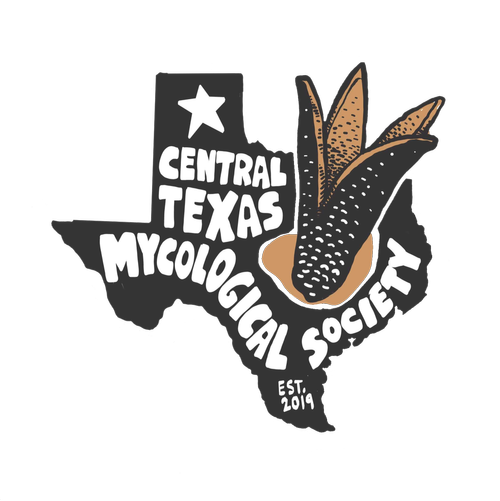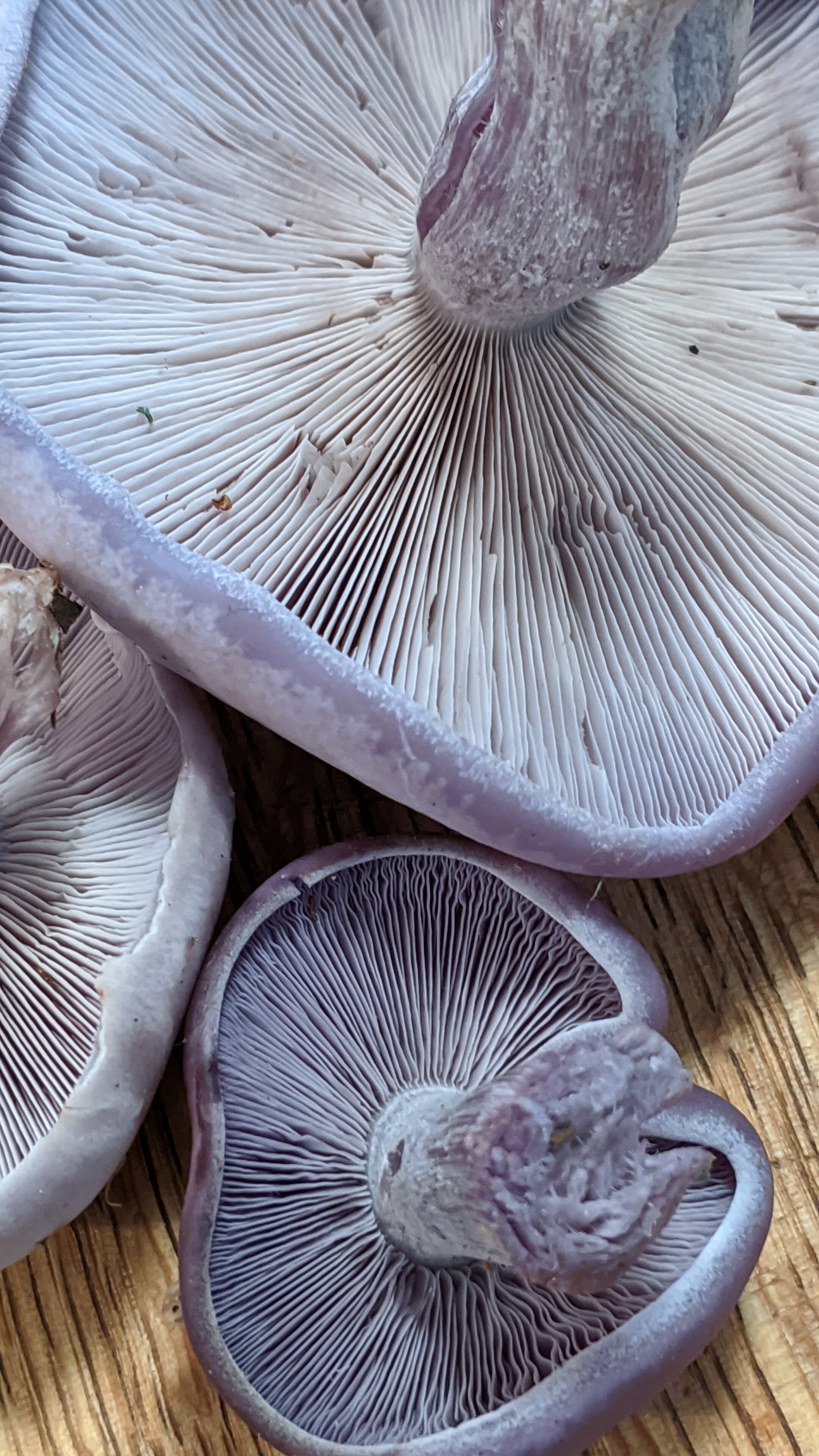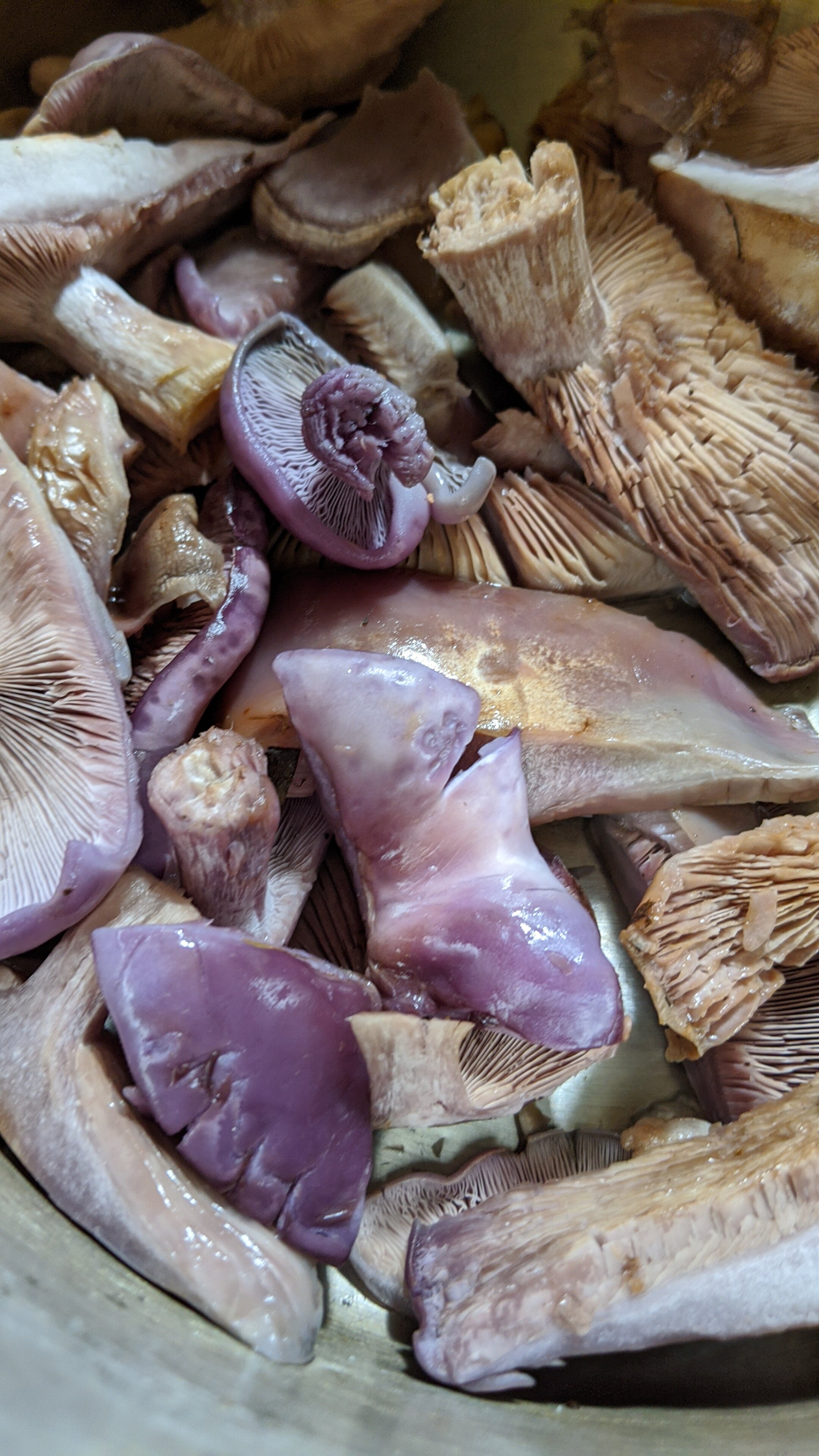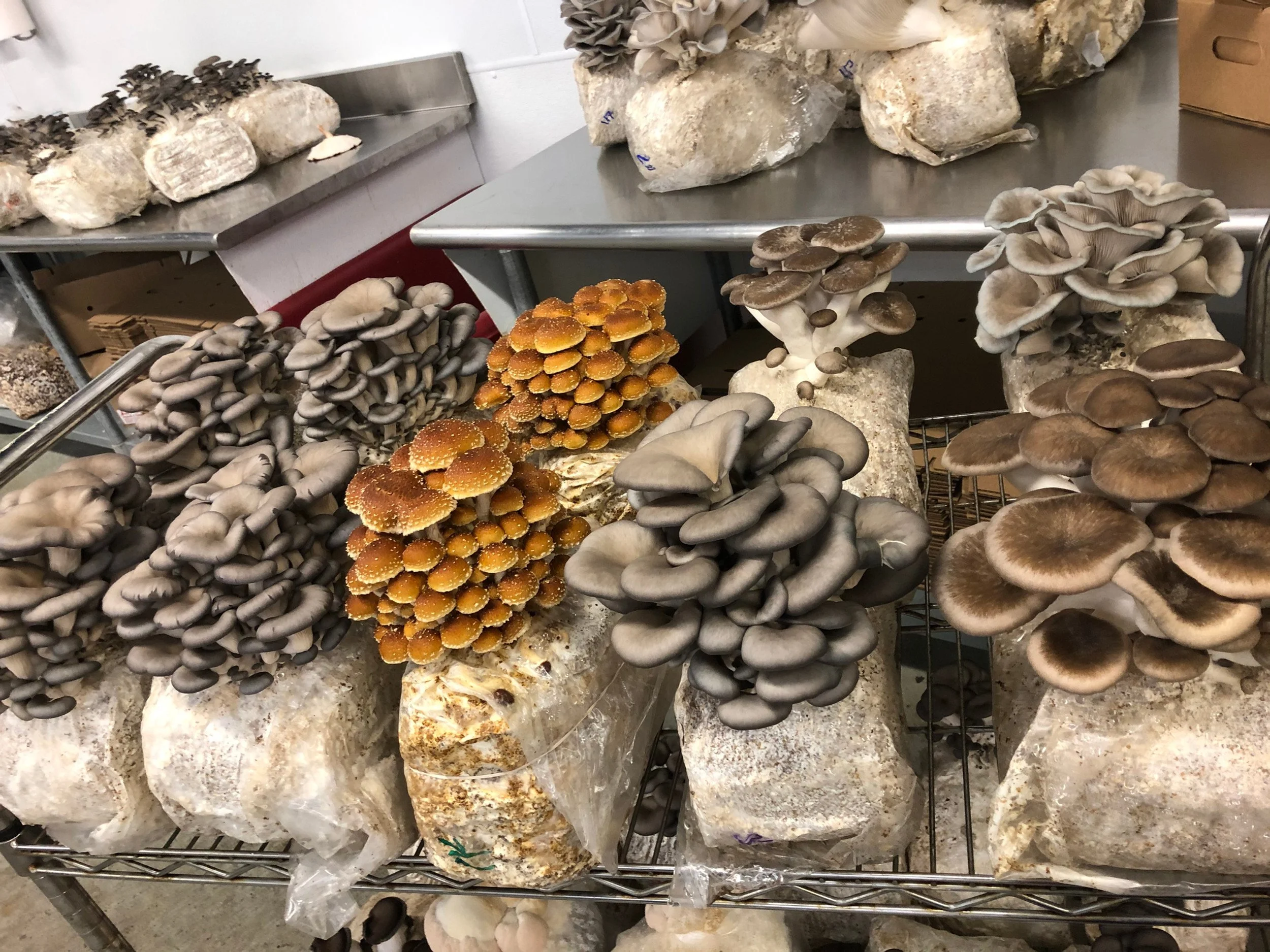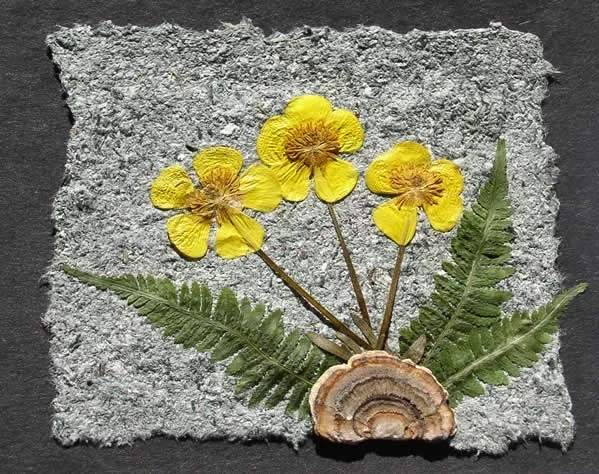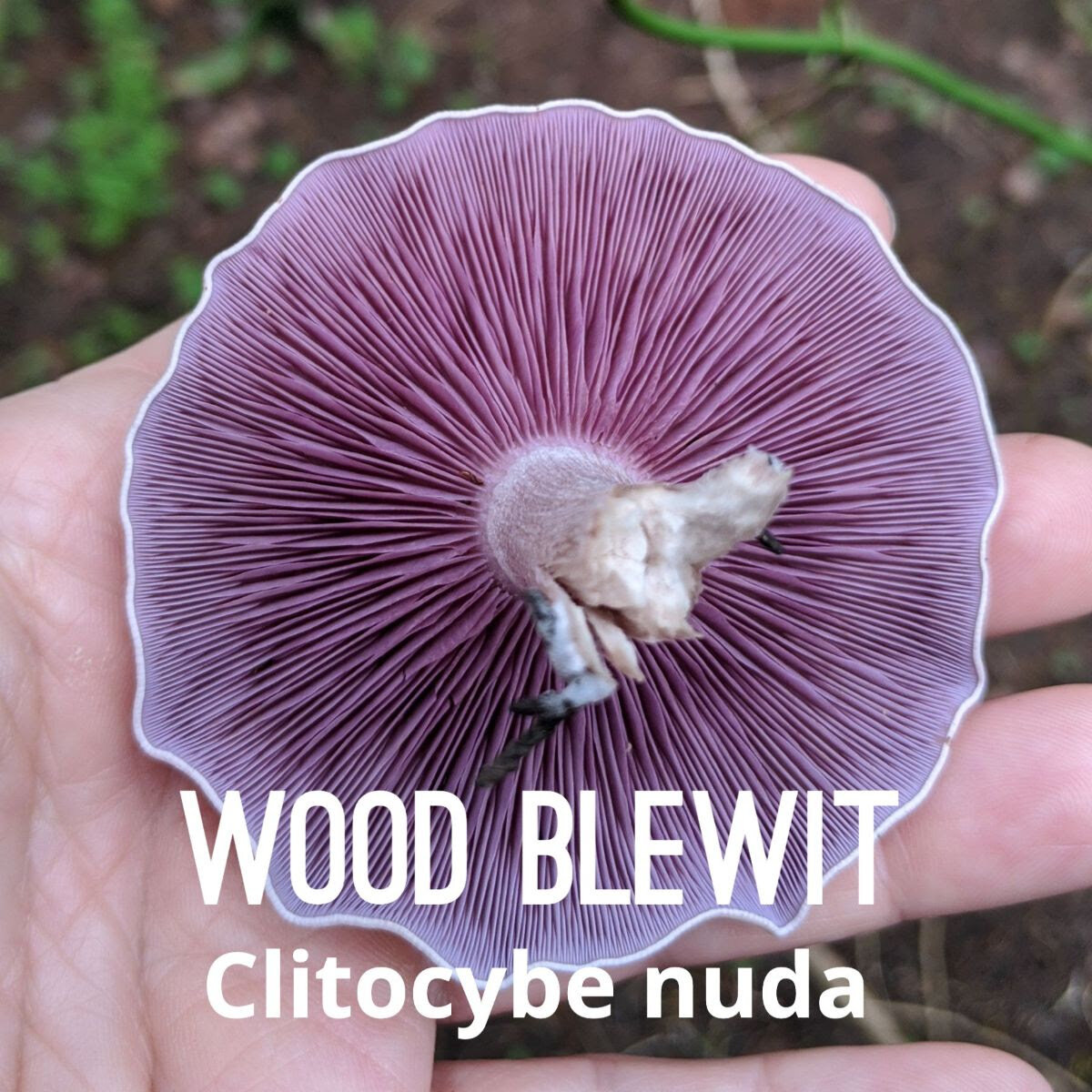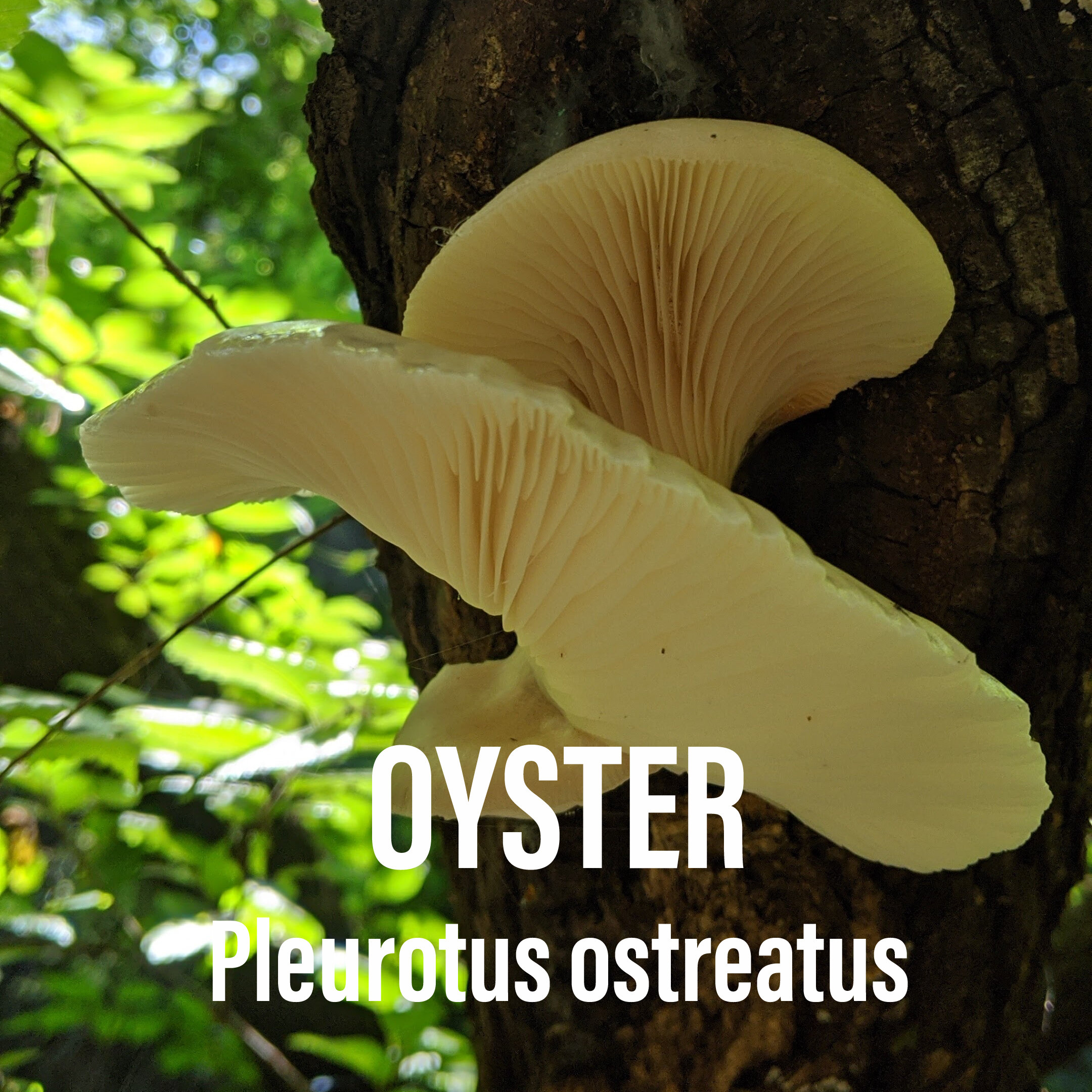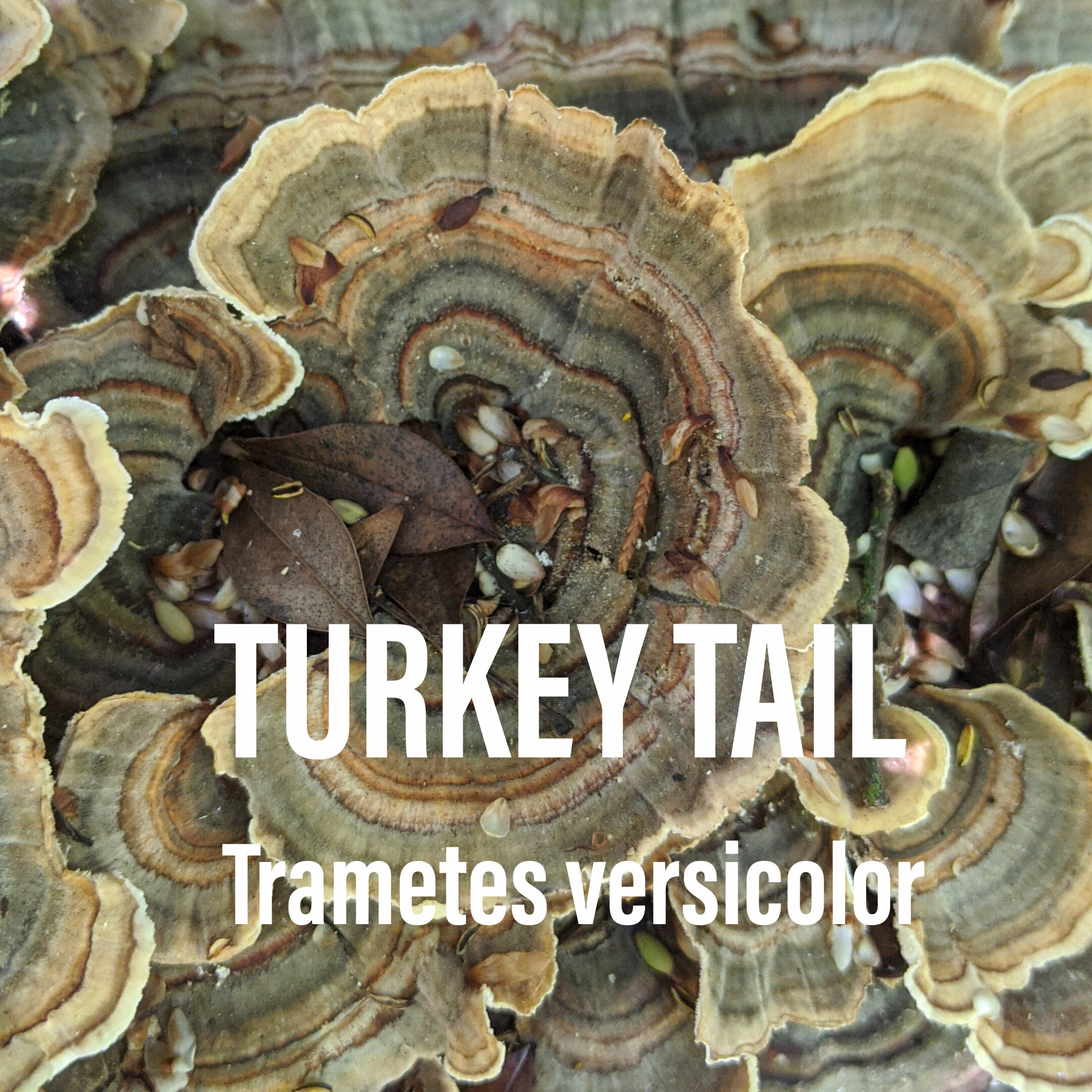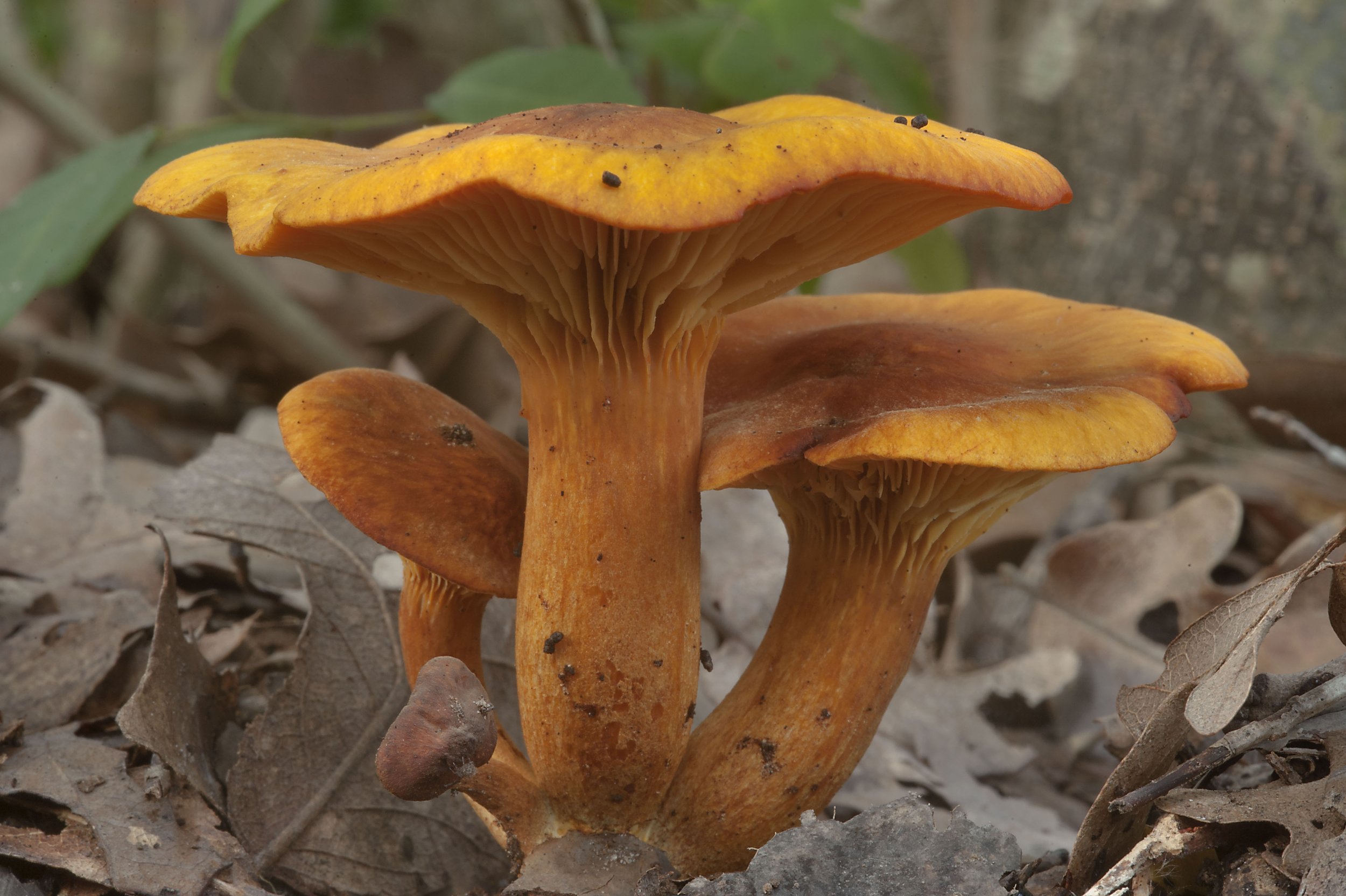Identifying Wood Blewits from Cortinarius Look-a-likes
Yesterday, I checked a few spots for the distinct, lavender colored Wood Blewit, Clitocybe Nuda, which are an good edible mushroom. Wood blewits can be confused with a purple species of the genus Cortinarius, which includes several poisonous species that grow in the same habitat. Just yesterday I found the two mushrooms growing in same habitat. Here’s a few tips for distinguishing the two.
Yesterday, I checked a few spots for the distinct, lavender colored Wood Blewit, Clitocybe nuda, which are an good edible mushroom. Wood blewits can be confused with a purple species of the genus Cortinarius, which includes several poisonous species that grow in the same habitat. Just yesterday I found the two mushrooms growing in same habitat. Here’s a few tips for distinguishing the two.
identifying EDIBLE WOOD BLEWITS
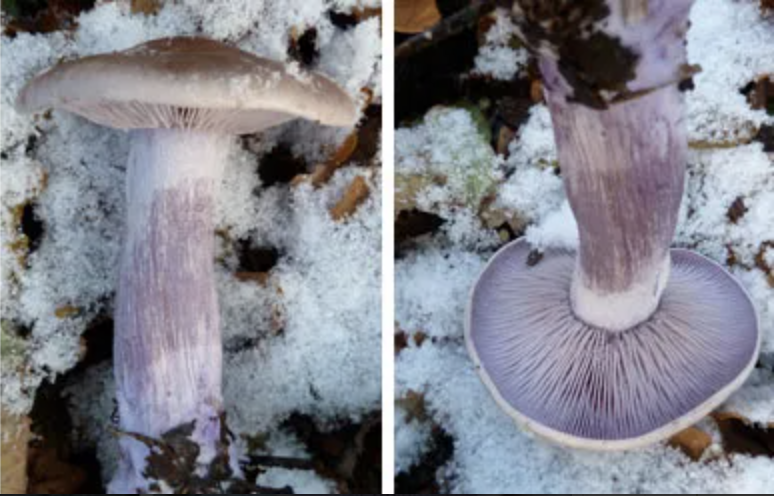
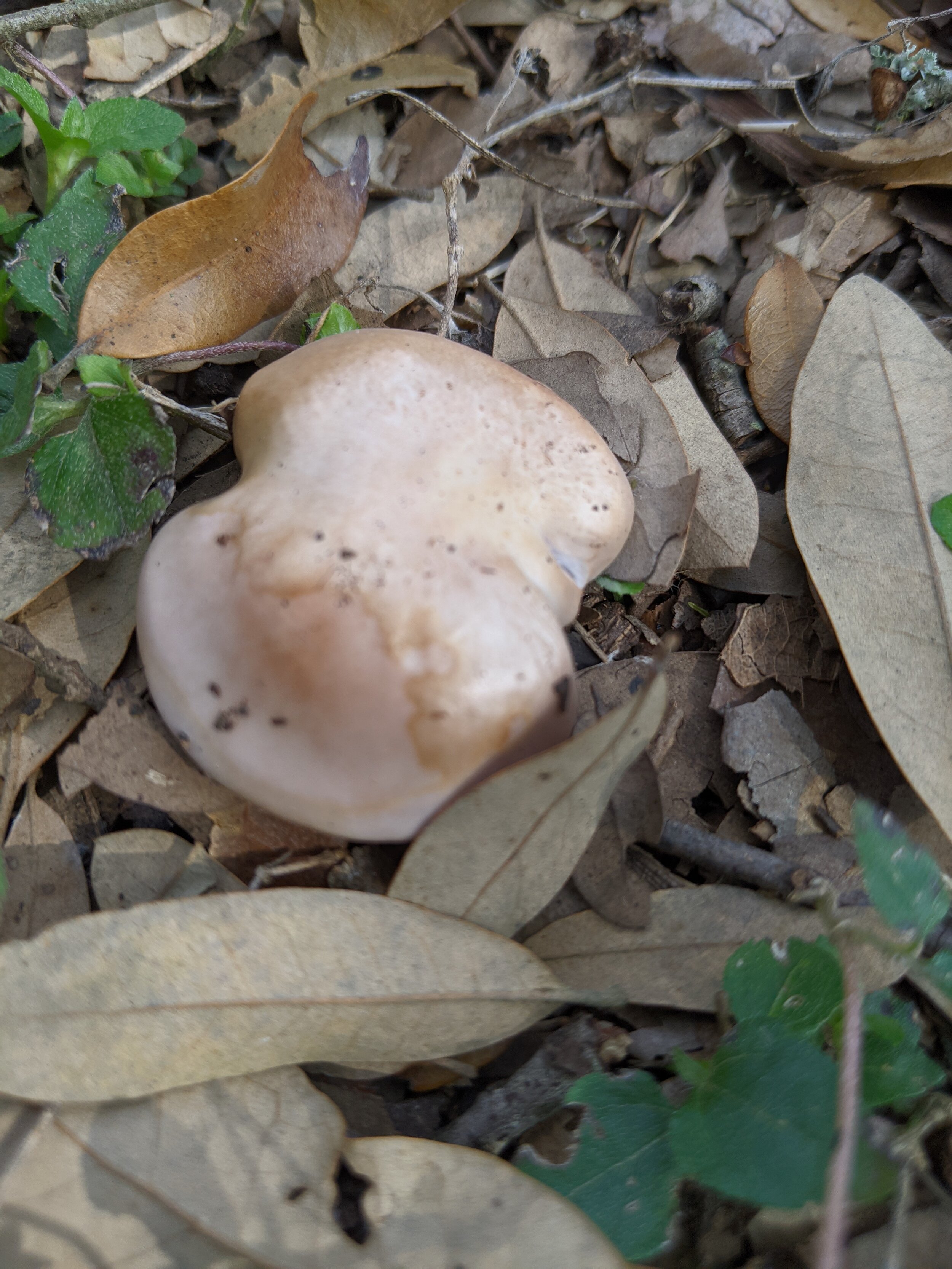
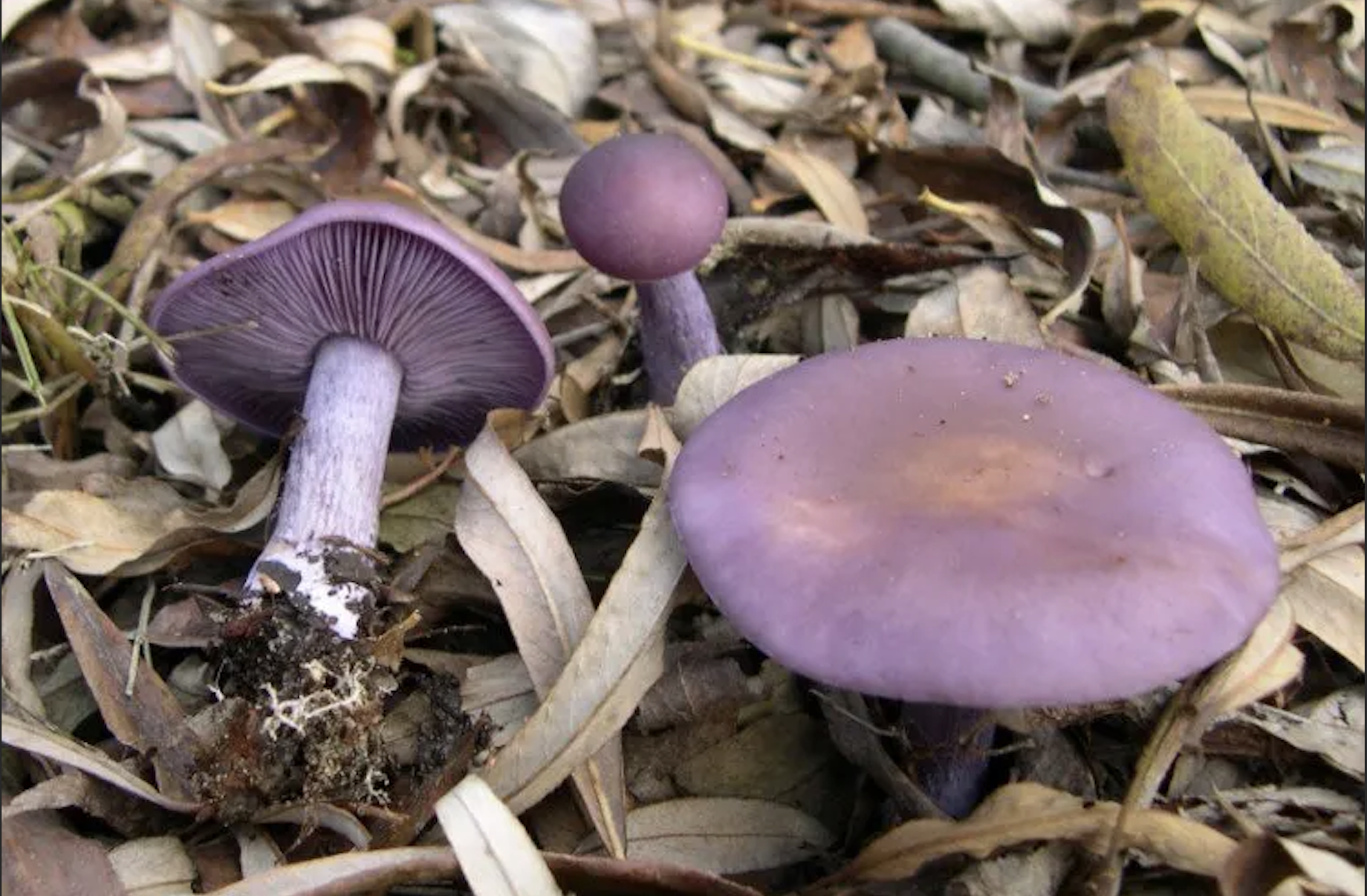
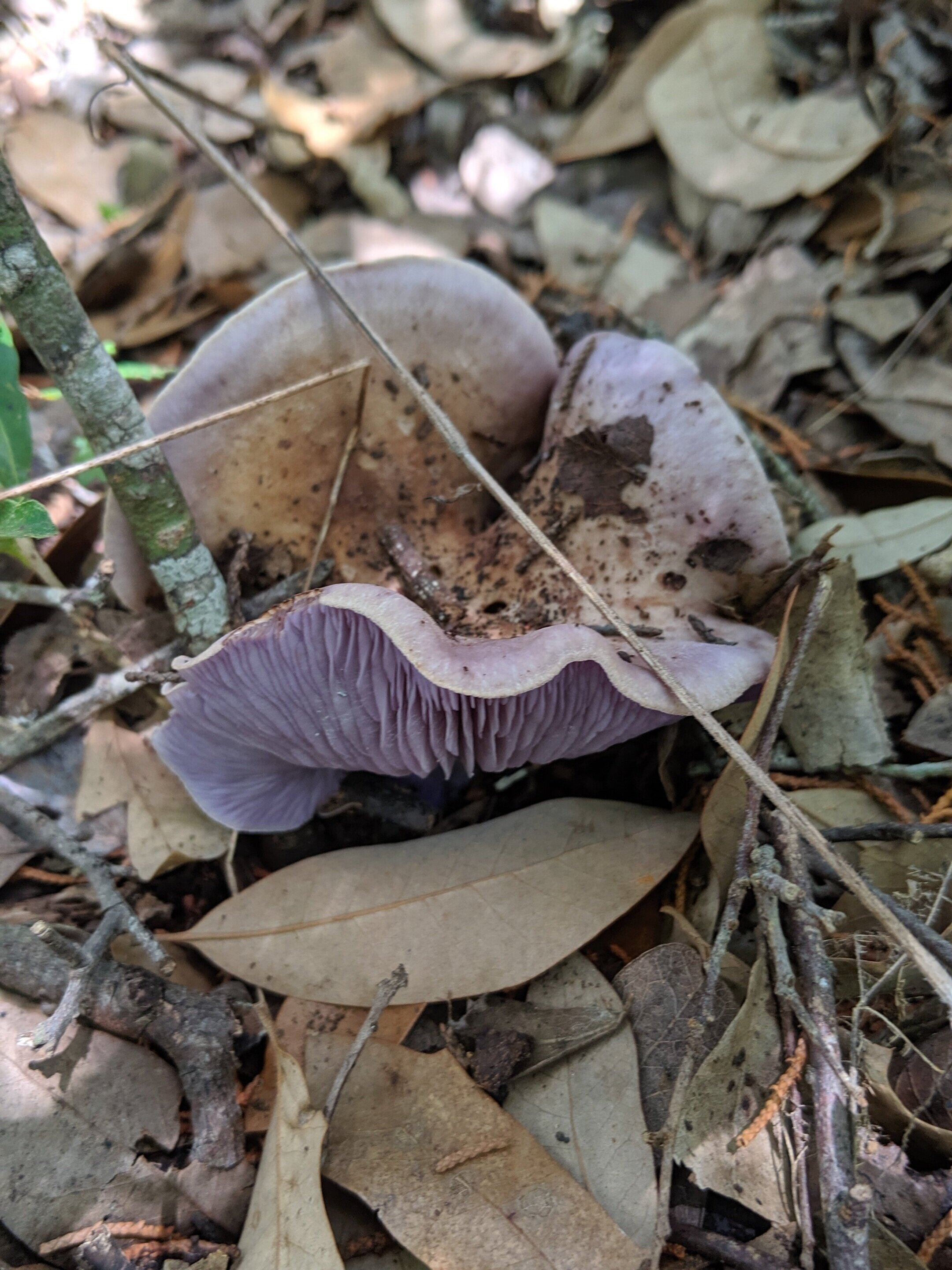
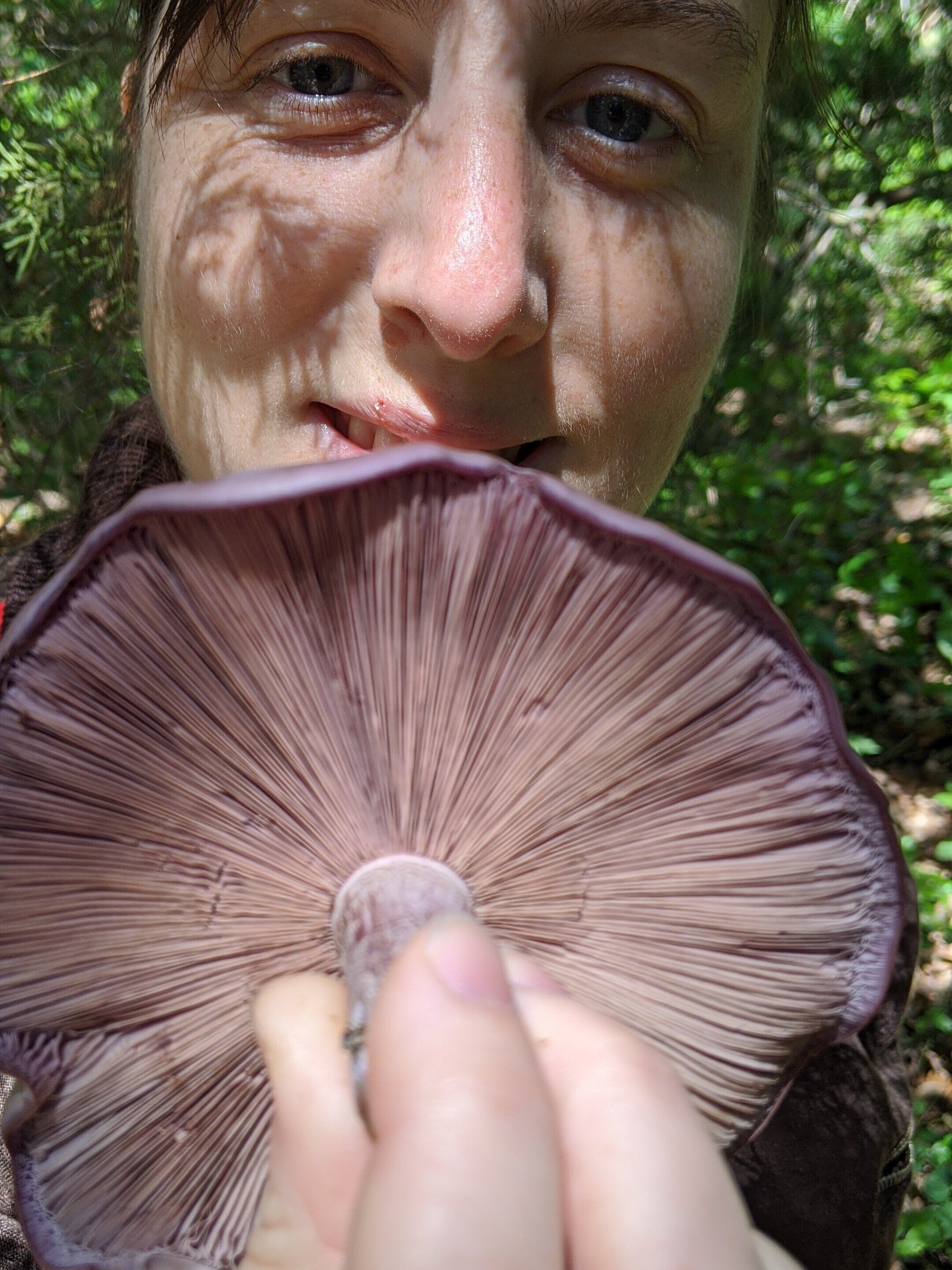
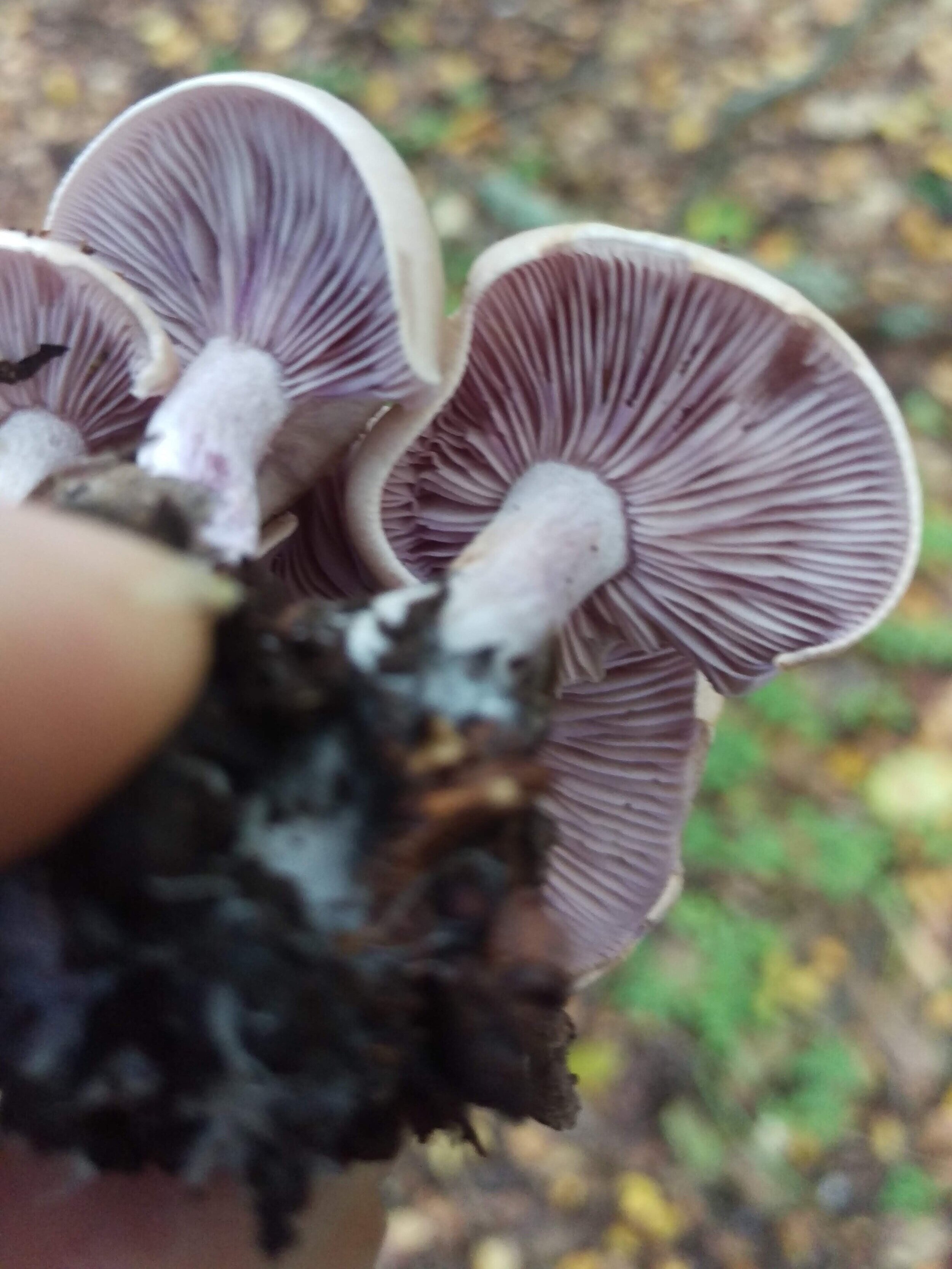
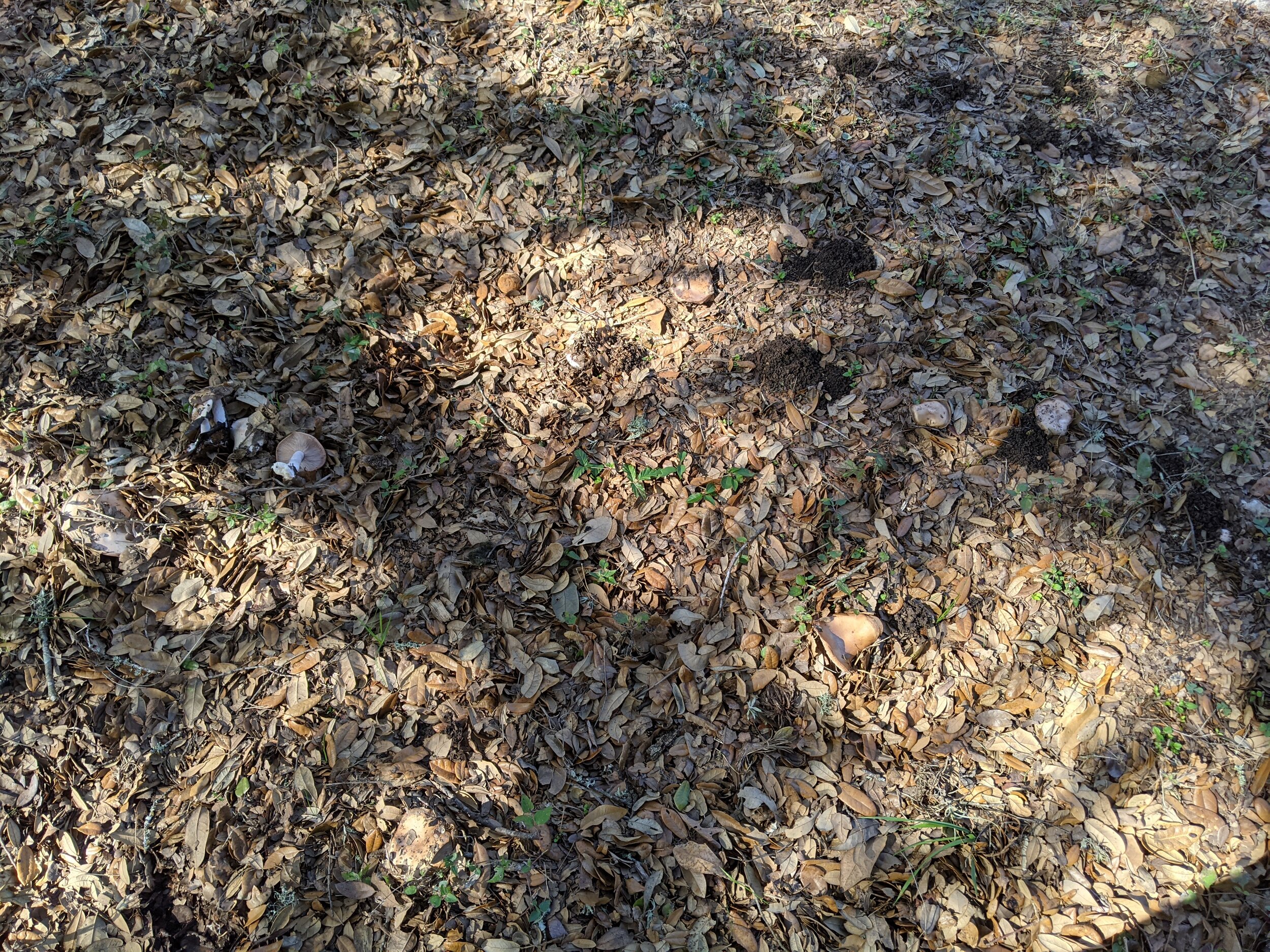
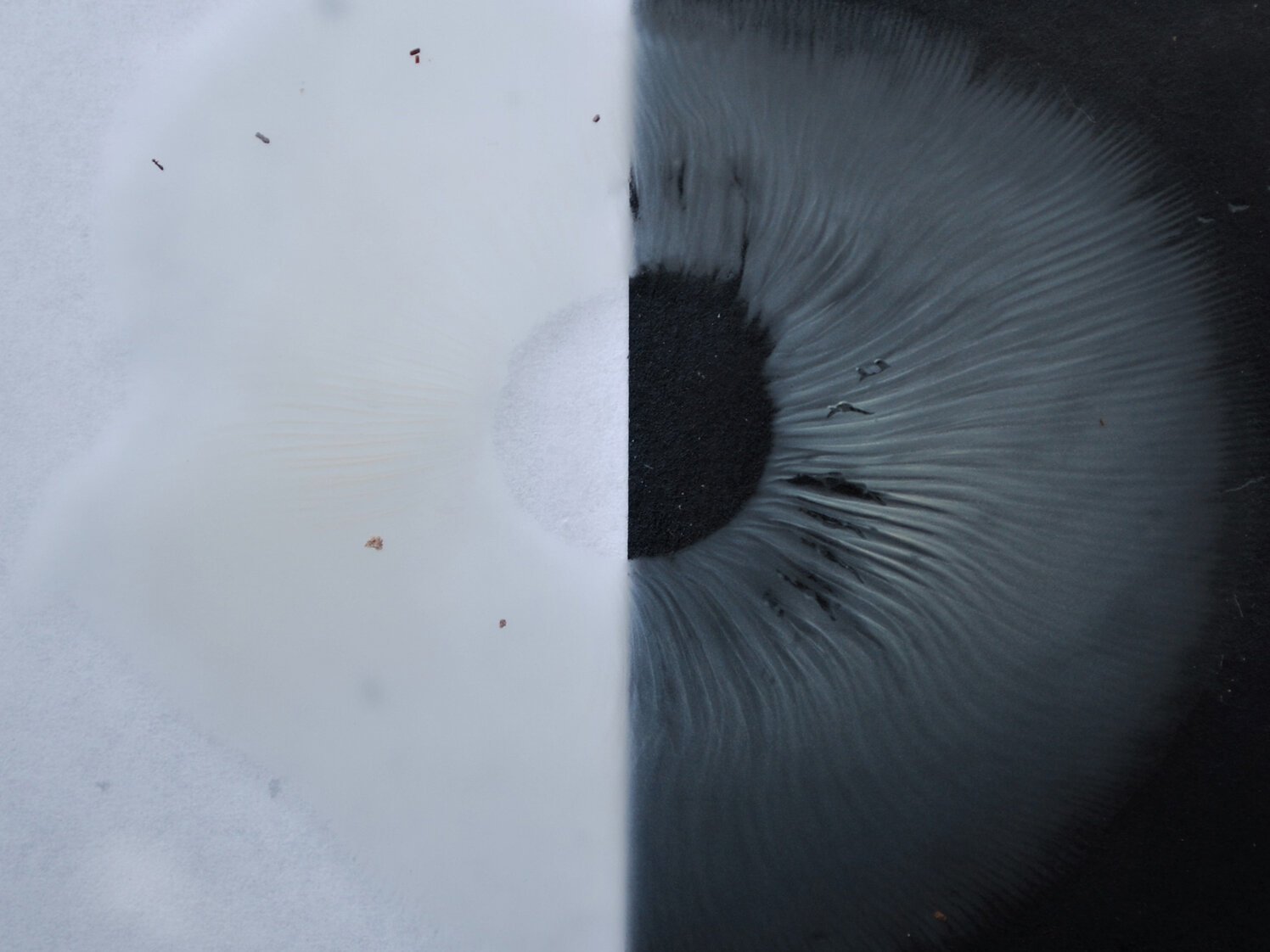
Blewits can be found naturally fruiting during the fall and winter months in Central Texas. I have found them as late as June when we have a rainy year like 2019. They need a heavy frost or freeze to initiate fruiting, so Blewits will not fruit in tropical climates below Central Texas.
The mushroom fruits in hardwood leaf litter under Live Oak trees and near Cedar/Juniper Ash trees in Central Texas. These mushrooms are a saprotrophic species, growing on leaf litter, recycling nutrients back to the soil.
Blewits have a standard “mushroom” shape: simple cap, a thick, stocky stalk, tight gills. There will be no ring or veil around the stalk.
The cap is smooth, almost suede-like appearing lavender purple if there is humidity. It will have leaf litter stuck to it from time to time, but it will NEVER be slimy or viscid. Blewit caps are often beige to mauve. As the mushroom ages, the edges of the cap will get wavy and appear shiny and iridescent when light hits it.
The lavender color on a blewit is concentrated underneath on the gills, although the cap and stalk will be a little purple, too. The gills are close together.
The stalk or stem of the mushroom is bulbous at the bottom and usually has leaves stuck to it when plucked from the ground.
It is rare to find just one blewit and they will often pop up in loose arcs or rings. Blewits do not grow in bunches or on dead wood.
The spore print is one way to be confident with your ID. When you do a spore print — cut the cap off a mushroom and place it, gills down, on a white piece of paper — the spores should light in color, a whitish dull pink to pinkish beige. Their poisonous lookalike, the Cortinarius, has darker, rusty-colored spores.
identifying POISINOUS Cortinarius
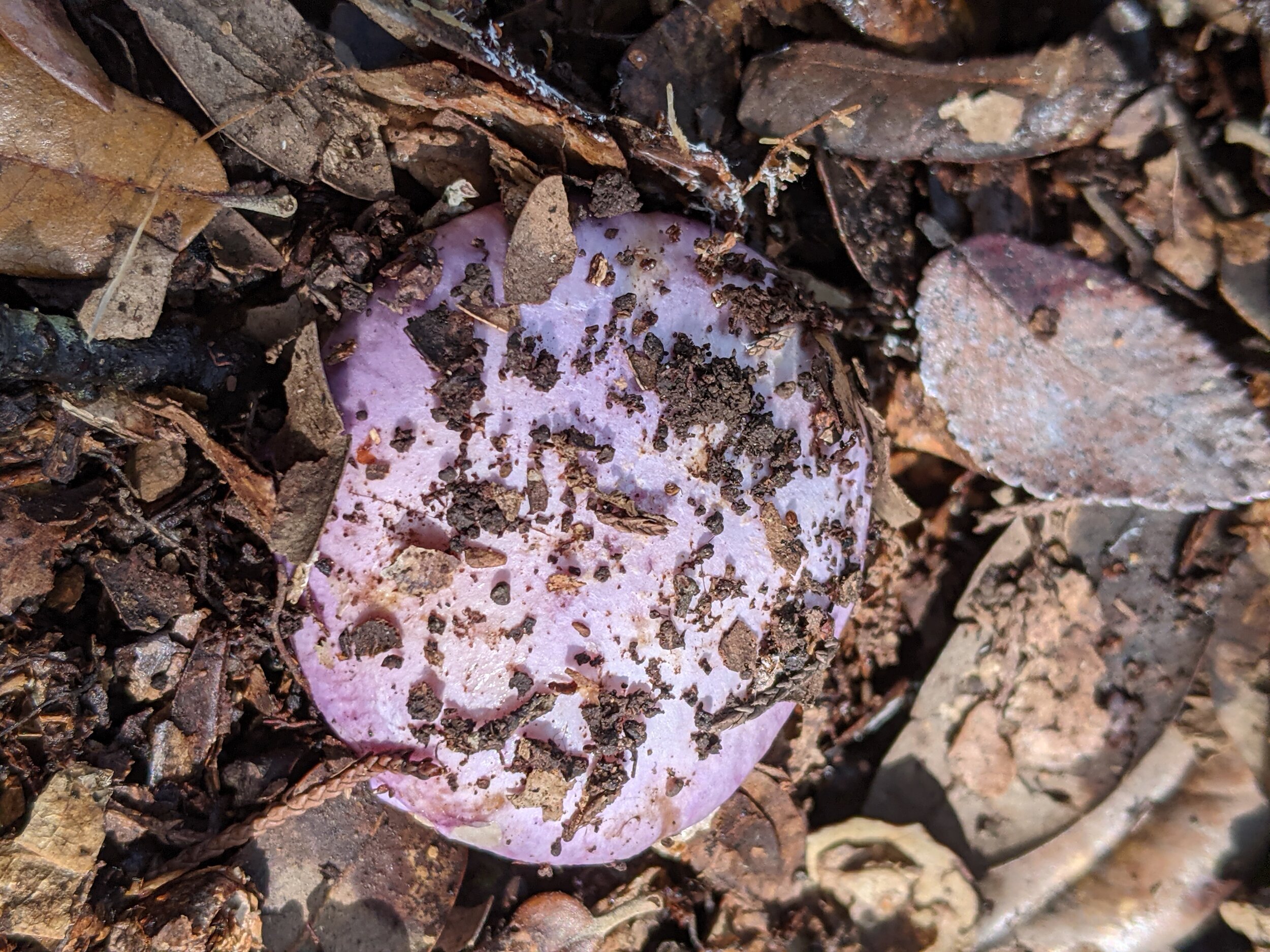
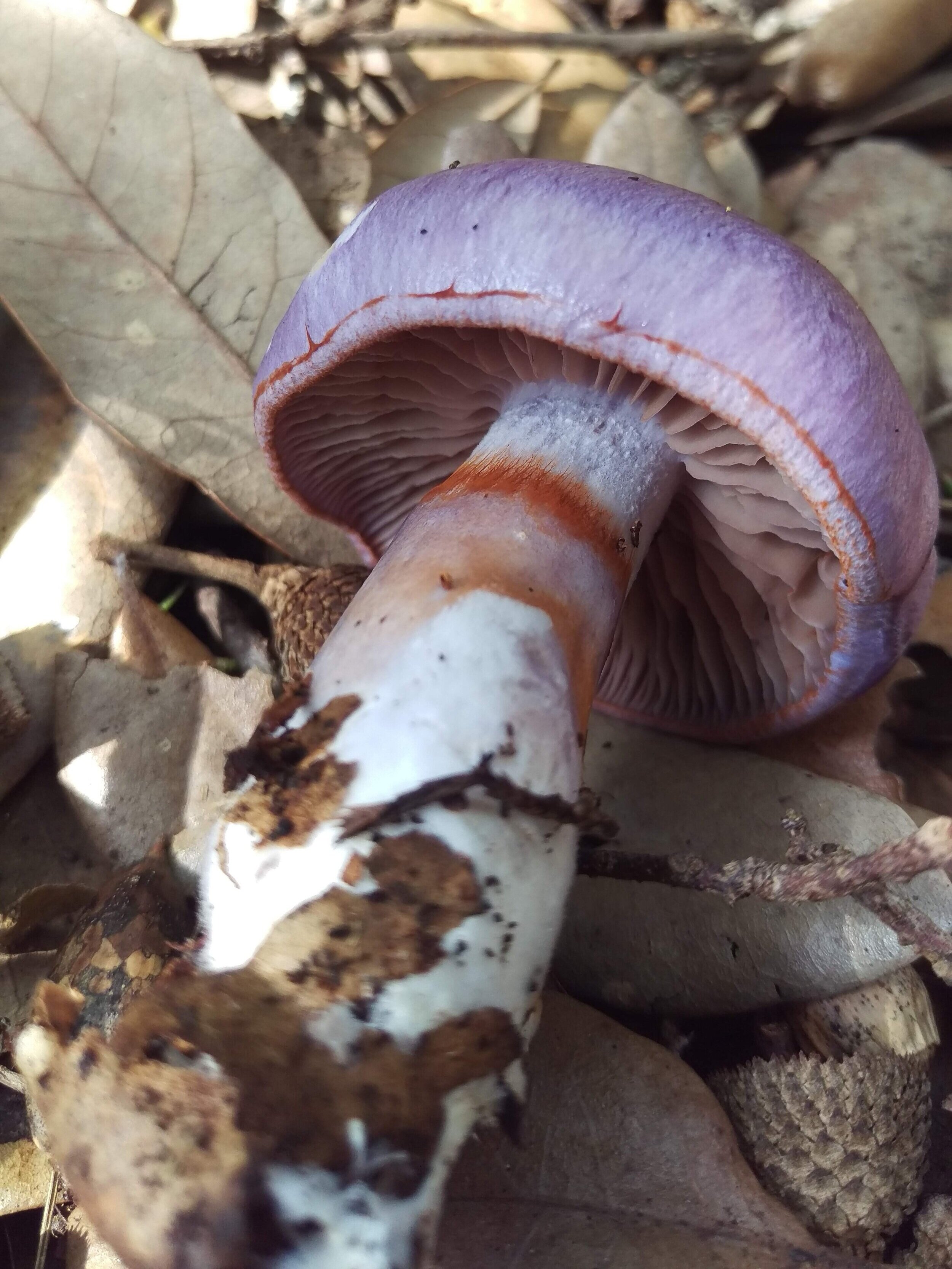
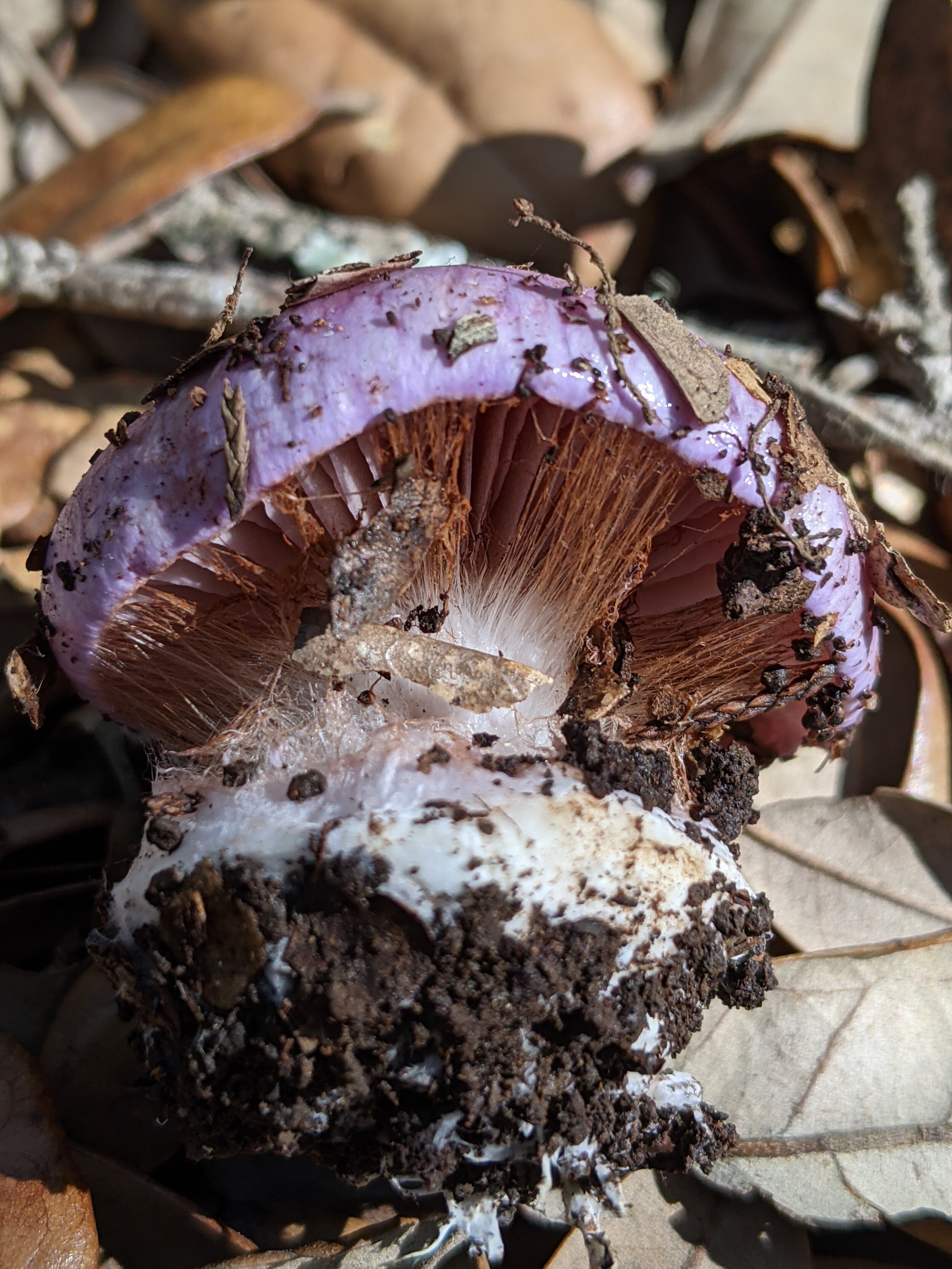
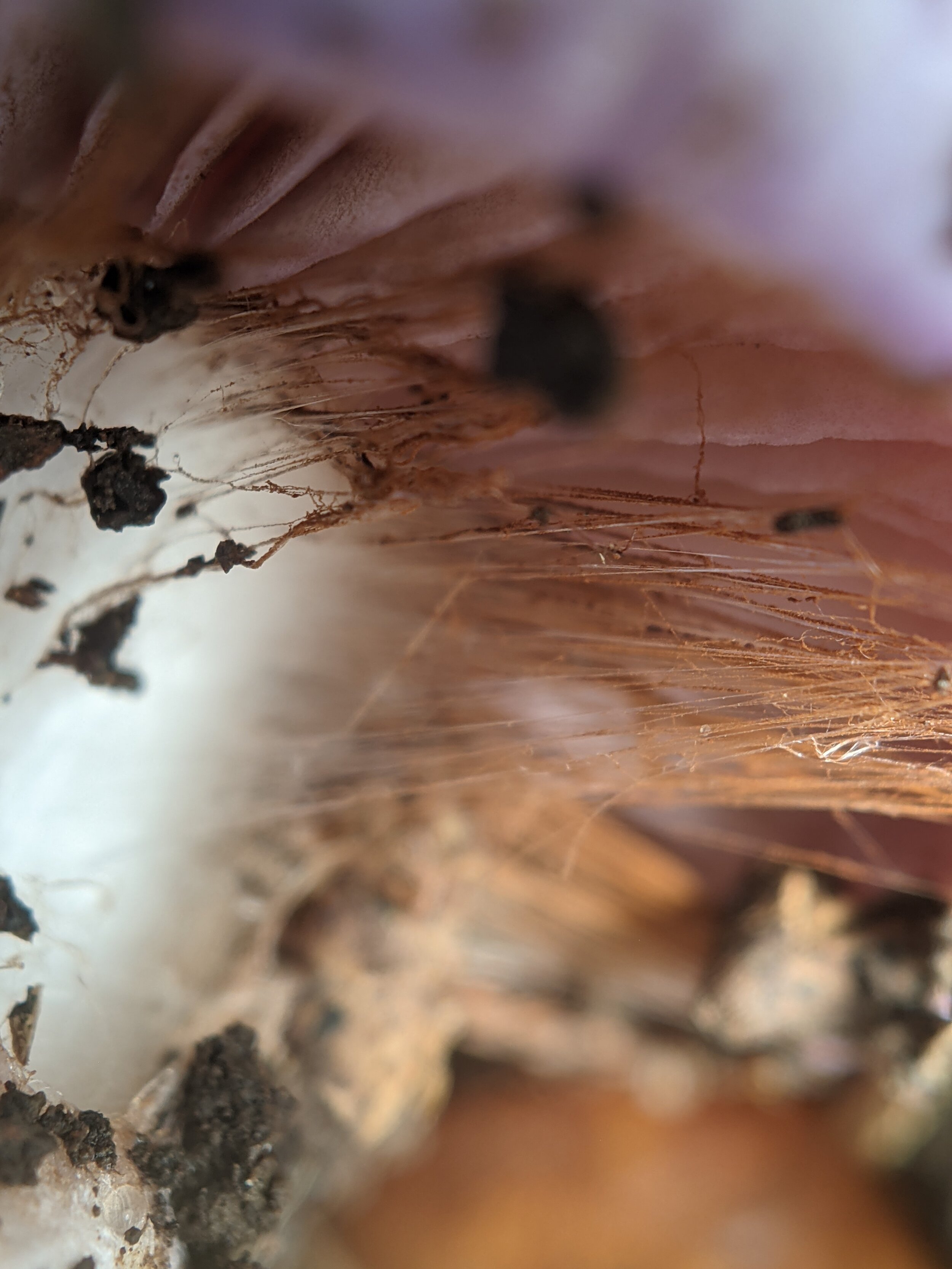
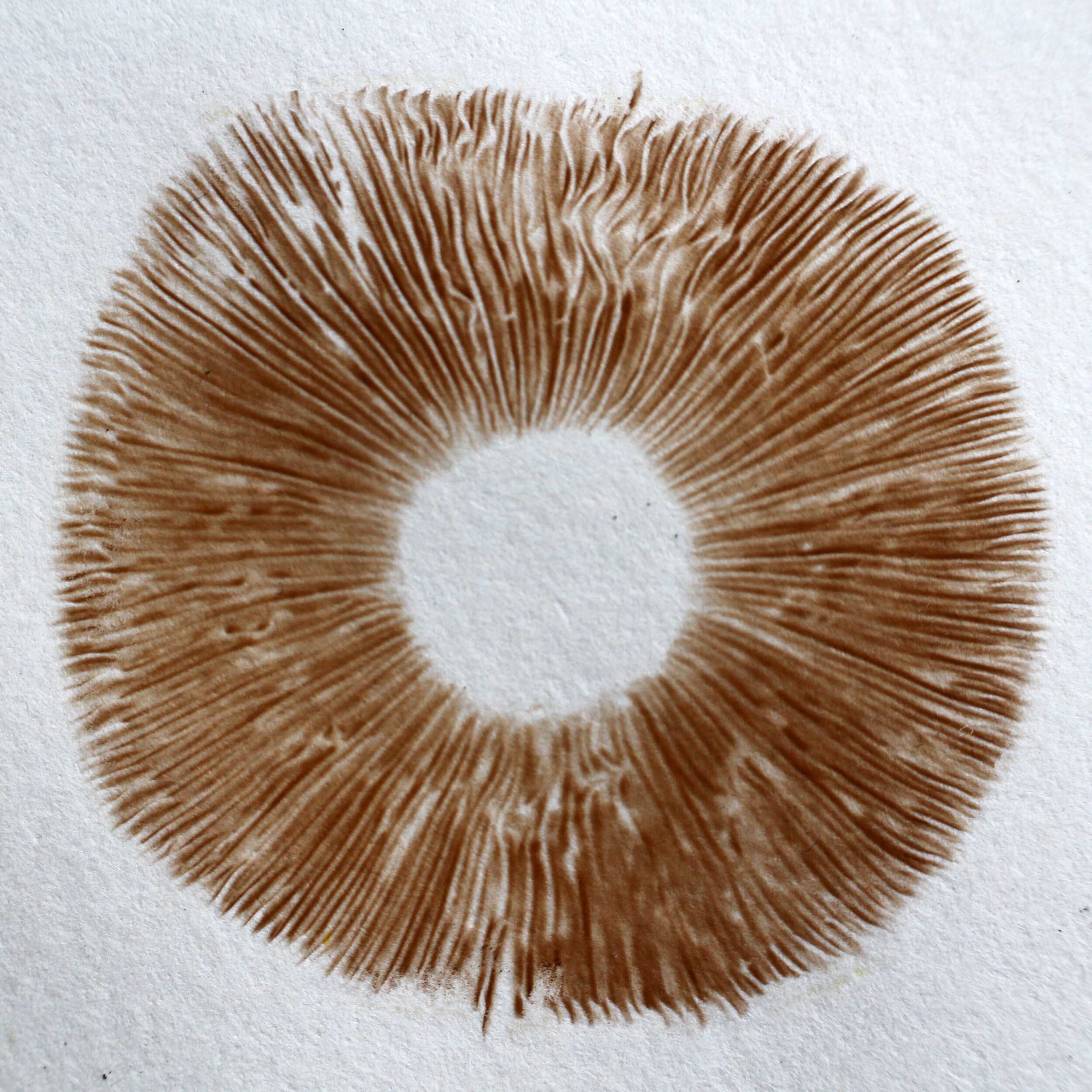
Cortinarius mushrooms will have a slimy, more purple cap.
Around the the stem you will see rusty color that match the color of the visible rusty spores.
Underneath you will find a “cobwebs” around the veil of the cap — those are Cortinarius or webcaps, which include several toxic species.
It's important to do a spore print AND also confirm the ID with an expert. The spores of the wood blewit are light pink to white and the spores of mushrooms are rust colored.
CULTIVATING WOOD BLEWITS
The wood blewit has been cultivated in Britain, the Netherlands and France. Cultivated wood blewits are said not to taste as good as wild wood blewits. I throw the older, bitter wood blewits in my compost pile. I gave a few to Carter from the Myco Research Station at Circle Acres to experiment with.
COOKING WOOD BLEWITS

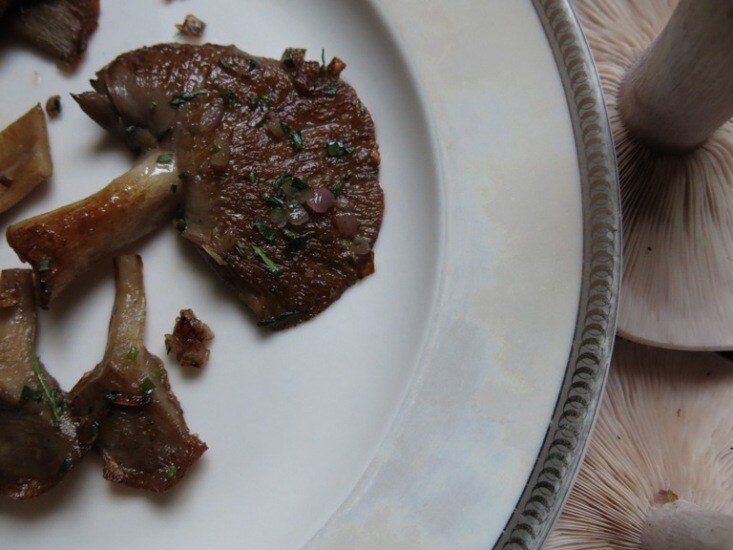
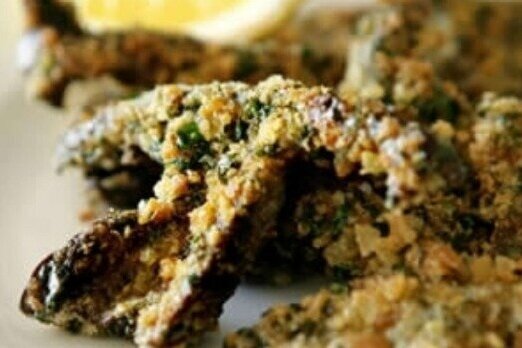
Wood blewits are a good edible, but don’t have the distict flavor of choice edible mushrooms like chanterelles, morels, and porcini. Wood blewits contain the sugar trehalose, which is edible for most people. Blewits can be eaten as a cream sauce or sautéed in butter are great with eggs in breakfast tacos. They have a strong flavor, so they combine well with garlic, leeks or onions. Wood blewits can be preserved in olive oil or white vinegar after blanching. It is always important to cook mushrooms before eating, to break down the chitin. Uncooked mushrooms can cause allergic reactions in sensitive individuals.
RECIPES LINKS
Wood Blewits, Purple Potatoes and Steamed Hake
Dry Sauteed Blewits with Shallots and Tarragon
Bonus Fact from WIkipedia
In Australia, male satin bowerbirds collect blue objects to decorate their bowers with. A young male was reported to have collected wood blewits to this end near Braidwood in southern New South Wales.
By Angel Schatz
Angel Schatz is a resident in Austin, TX, originally from St. Louis area. She worked in digital design and animation for about 15 years. More recently her work has moved to the analog world where I focus on digital content and leadership around food systems, in helping others build resilience in everything from foraging, urban gardening, and doing art.
My interest in mushrooms started at a young age when hunting for morels in the midwest with my granddad. It was rekindled when I found that morels grow in Texas. I found my first Texas Morel this past year!
Follow my adventures @forage.atx.
January Mushroom of the Month: Arthrophaga myriapodina
The January mushroom of the month is Arthrophaga myriapodina, another Zombie Fungus!





The January mushroom of the month is Arthrophaga myriapodina, another Zombie Fungus!
🙌 to Leigh for naming that mushroom correctly and becoming the 1,259th member of Central Texas Mycology! Become a supporting member to stay dialed-in with events & discover next month’s mystery mushroom.
What IS it?
It’s Another Zombie Fungus!
A new species and genus of fungus, Arthrophaga myriapodina kills flat backed millipedes. This species was first seen over a century ago but never described until 2017. Similar to the zombie ant fungus, this one also induces pre-death climbing behavior in its hosts and once it reaches a high vantage point, the millipede makes a death grip and the fungus forcibly-discharges spores.
WHERE CAN I FIND IT?
They are in Texas!
iNaturalist and Mushroom Observer observations and study of fungarium specimens suggest the fungus occurs widely in eastern North America with the furthest west occurring in Central Texas then several in northern California. Using a 365nm UV Flashlight, they can be easily found at night after several days of rain. Look for glowing millipedes holding on for dear life at high vantage points like tall grasses.
Can i get InFECted with this Fungus?
While zombie fungi are real and numerous, Mycologists aren’t worried about these types of fungus infecting people. “They’re super species-specific,” said Charissa de Bekker, an assistant professor in the biology department at Utrecht University in the Netherlands. “They have very refined machinery to interact with their hosts and do these really interesting things like changing behavior, but they can’t even jump from one species to the next,” let alone to an organism as distantly related as a human.
Source: CNN
📸 @swamppenwolf @forage.atx @damontighe @inaturalistorg
January Foraging Forecast
As the weather continues to cool, look out for the edible Wood Blewit, Clitocybe Nuda. This distinct lavender-colored mushroom is found in hardwood leaf litter and is a great decomposer.
BLEWIT: As the weather continues to cool, look out for the edible Wood Blewit, Clitocybe nuda. This distinct lavender-colored mushroom is found in hardwood leaf litter and is a great decomposer. Be warned because there are deadly, poisonous look-alikes in the Cortinarius family that grow in similar conditions. It's important to do a spore print AND also confirm the ID with an expert. The spores of the wood blewit are light pink to white and the spores of Cortinarius mushrooms are rust colored. Check out this blog post with lots of photos to help you with the correct ID.
Fresh wood blewits are great with eggs in breakfast tacos. As they get older they become more tan and iridescent colored on the cap and taste bitter. I throw the older wood blewits my compost leaf pile because they are such great decomposers and will colonize and grow in hardwood leaf litter.
OYSTER: Continue to keep an eye out for Oyster Mushrooms, Pleurotus ostreatus grows on dead black willows and oaks. There have been several observed along creeks and rivers recently.
TURKEY TAIL: The medicinal mushroom Turkey Tail, Trametes versicolor will also flush after rain on downed hardwood logs, stumps and, occasionally, on conifer wood. Make sure the underside is porous and white because it can look a lot like False turkey tail. Mushroom Expert has a useful check list to determine if it is true medicinal turkey tail.
As always, if you are trying a new mushroom, confirm the ID with an expert, then try a small amount to make sure you don't have an allergic reaction. Texas Mushroom Identification Facebook group is great for quick responses and ID help. Also, don't forget to add your finds on the Mushrooms of Texas project on iNaturalist.
Follow my adventures @forage.atx.
2023 Mycelial Growth
2023 has been an underground adventure, myceliating through rich soils, spores spreading from devil's cigars erupting into stars.
2023 has been an underground adventure, myceliating through rich soils, spores spreading from devil's cigars erupting into stars. Since our non-profits' founding in 2019 we have been volunteer powered, a fungal network that has organized community outreach, programming and our recycling program.
RECORD MEMBERSHIP
The membership has grown to over 1,200* supporters from 164 cities in 22 different states. You can support us with monthly, annual, or a one-time lifetime supporting membership donations. *This includes 225 volunteers who become automatic members.
300,000 Blocks Composted
Mountains of “spent mushroom blocks” have been rescued from the waste stream and are myceliating and building healthy soil and community. It is estimated that 300,000 blocks have been composted annually. We are grateful for the donations and volunteers that help us in this waste diversion initiative.
Record No. of Education Events
We had 165 education events in 21 Texas cities and 3 states, reaching over 18,000 students. The mycelium is running in the San Antonio region with several volunteer organizers helping activate the M.E.M.E Lab at Gardopia Gardens and a monthly line-up of educational events.
New Huitlacoche Experiment
We kicked off the first year of the Huitlacoche growing experiment with some success and some happy accidents. We inoculated several corn crops at Nixta Taqueria, Zilker Botanical Garden, Gus Garcia Community Garden and several home gardens. We plan to try some new methods this next year.
Health Soils, Healthy Trees
We wrapped up the first year of Healthy Soil, Healthy Trees, a partnership with City of Austin Urban Forestry Dept. and Ecology Action, to conduct community research and educational programs on mycorrhizal relationships in urban reforestation efforts and to reboot the Myco Research Station. Visit the temporary eco-art installation at Circle Acres.
What’s in Store for 2024:
Camping Forays
Foraging Walks
Chef Collaborations
K-12 Curriculum
This next year we hope you will join us in becoming a supporting member as we
continue to be wowed by fungi!
Enter to Win a Texas Mushroom Tee
Your feedback is essential to us. Take a few moments to share your thoughts on this year’s educational events and be entered to win. Your response will help us improve future events and create a better experience for all!
How You Can Support
🧧Become a supporting member or give a membership gift card.
👕Purchase merch including our new Texas mushrooms tee with a design from Mystic Multiples.
✋Volunteer and help us keep organic matter out of the waste.
🍄 Give a ♻️🍄🧱 underneath your trees to protect them this coming winter.
💸 Make a donation to support mycology education and the recycling program.
December Mushroom of the Month: Amanita persicina
The December mushroom of the month is Amanita persicina, known commonly as the Peach Fly Agaric.






The December mushroom of the month is Amanita persicina, known commonly as the Peach Fly Agaric. Recent DNA evidence has indicated that Amanita persicina is better treated as a distinct species, and it was elevated to species status in 2015. Scroll to learn more and where to find in Texas and how it is being used as a medicine for anxiety and depression.
🙌 to @mullenjoseph for naming that mushroom correctly and becoming the newest member of Central Texas Mycology! Become a supporting member to stay dialed-in to the wood-wide-web and join us for events & discover next month’s mystery mushroom.
Can I EAT it?
It is both poisonous and psychoactive.
The mushroom contains the neurotoxin ibotenic acid which can be decarboxylated into Muscimol, a legal, psychoactive compound. A few studies show it inhibits neuronal and glial GABA uptake, helping with depression, anxiety, muscular pain and promote sleep. In the last few years Muscimol has become a popular ingredient in medicinal mushroom products.
Hometown Hero is one local company that sells “Magic Muscaria Gummies.”
WHERE DOES IT GROW?
In East Texas
Amanita persicina is mycorrhizal with conifers (Loblolly Pine) and deciduous (Oak & Hemlock) trees and can be found in the late fall to early spring. The cap color varies from bright red and fades to yellow to orangish peach. Additionally, the universal veil material is usually present merely as scattered fragments and patches, rather than the well defined concentric rings and zones that characterize the other North American varieties.
Is Santa Really A Mushroom?
Some believe the myth of Santa is derived from shamanic uses of the Fly Agaric mushroom near the north pole. Fungi Foundation has cataloged 200 ancestral and traditional uses of this mushroom. Some uses are by shamans in the northern hemisphere for purposes such as communicating with spirits, increasing courage and inducing altered states of consciousness. Fact or fiction? Just a cute Christmas card design? We are glad that indigenous uses of mushrooms are being cataloged and protected for future generations.
BECOME A SUPPORTING MEMBER & stay Dialed in with events & discover next month’s mystery mushroom.
November Mushroom of the Month: Trametes Versicolor
The November mushroom of the month is Trametes versicolor commonly known as Turkey tail.





The November mushroom of the month is Trametes versicolor commonly known as Turkey tail. Turkey tail decomposes rotting wood and is used in traditional Chinese medicine and has been found to improve response to cancer medicines and radiation. It is also used for muscle strength, fatigue, UTIs, and many other conditions. Fortunately, there are no toxic look-alikes which generally makes them a “safe”mushroom to forage. Swipe to learn how to identify Turkey Tail, Trametes versicolor from False Turkey Tail, Stereum ostrea.
🙌 to Erika for naming that mushroom correctly and becoming the 1,174th member of Central Texas Mycology!
Can I EAT it?
Sort of, It’s Medicinal
Turkey tail decomposes rotting wood and is used in traditional Chinese medicine and has been found to improve response to cancer medicines and radiation. It is also used for muscle strength, fatigue, UTIs, and many other conditions. Fortunately, there are no toxic look-alikes which generally makes them a “safe”mushroom to forage.
how to identify Turkey Tail, Trametes versicolor from False Turkey Tail, Stereum ostrea.
The key to identification of turkey tail is the underside.
Similarities
Polypore
Grows on decomposing wood
Thin and flexible
Concentric growth rings on the cap
Irregular outer margins
Differences
False has smooth, tan underside and pores are not visible. True has white pores that are visible.
False has green algae that grows on it. True does not.
False grows upwards to the edges. True often has flat growth.
5 STEPS to Correctly IDentify
Does it have visible, multi-colored concentric zones?
Is it thin and flexible? (1–3 millimeters thin)
Does the top feel velvety?
Is the underside white? (Gets more yellow with age.)
Does the underside have small pores?
BECOME A SUPPORTING MEMBER & stay Dialed in with events & discover next month’s mystery mushroom.
Ghoulish Mushroom Skull Recipes
Happy Halloween! Check out some of our favorite skull mushroom recipes from around the web.
Halloween Pasta Salad
A ghoulishly delightful blend of eerie ingredients like black pasta, mozzarella eyeballs, and mushroom skulls coated in Italian dressing, that’s perfect for a hauntingly delicious celebration.
Skull & Pumpkin Soup
This skull and pumpkin soup is so easy to make and although this is a lentil and vegetable soup you could make this with meat or make this with your favourite soup recipe.
Keto Mushroom Skull Recipes
We made these mushroom skulls as part of our keto Halloween celebrations and served them in many different ways. These tiny skulls make a healthy vegan dish or appetizer.
Bread of the Dead
A dramatic and delicious take on flatbread pizza made with savory mushroom skulls, shallots and herbs topped with a balsamic glaze drizzle. Enjoy!
October Mushroom of the Month: Omphalotus subilludens
The October mushroom of the month is Omphalotus subilludens commonly known as Southern Jack-o-lantern.





The October mushroom of the month is Omphalotus subilludens commonly known as Southern Jack-o-lantern. We thought this one was an easy one but many of you guessed it was a chanterelle which is edible and the southern jack-o-lantern is toxic. Scroll to learn the differences and more about how this mushroom glows in the dark like a jack-o-lantern.
🙌 to @erociovergara for naming that mushroom correctly and becoming the 1,174th member of Central Texas Mycology!
Can I Eat It?
NO! It’s toxic!
It won’t kill you but you will wish you were dead. It contains the toxic chemical illudin that can cause severe stomach upset, vomiting, diarrhea and headache. A real nightmare on Elm Street. It gets commonly confused with the choice edible, chanterelle.
CHANTERELLEs
Mycorrhizal: Grows typically as a single mushroom in symbiosis and within several feet of living Live Oak trees.
Gills: False or folded and run down the stem (decurrent).
Stem: When peeled, pale orange on the inside
Season: Spring and Fall during high humidity like after Texas style flash floods.
Southern Jack-o-Lantern
Saprophytic: Decomposes and fruits in clusters at base of stumps or buried roots.
Gills: True, sharp, non-forking gills that are decurrent or adnate (like shown above).
Stem: bright to dark orange on inside
Season: Spring and Fall after rains.
IT Glows in the dark!
Bioluminescence, a blue-green color, can be seen in the gills of fresh specimens in low light once the eye becomes dark-adapted or with long exposure photo-graphy. This is due to the enzyme luciferase, acting upon a compound called luciferin, leading to the emission of light similar to the way fireflies do when glowing. Scientists have found the glow attracts insects that then spread the mushroom spores.
BECOME A SUPPORTING MEMBER & stay Dialed in with events & discover next month’s mystery mushroom.
September Mushroom of the Month: Kretzschmaria deusta
The September mushroom of the month is not a fun one: Kretzschmaria deusta commonly known as Brittle cinder.






The September mushroom of the month is not a fun one: Kretzschmaria deusta commonly known as Brittle cinder. You may have heard about it recently in the news, as one of Austin’s beloved pecan trees Flo, a centurion living on the banks of Barton Springs pool, has been diagnosed with this deadly fungus.
🙌 to Braden for naming that mushroom correctly and becoming the 1,188th member of Central Texas Mycology!
what is it?
Brittle cinder fungus, or Kretzschmaria deusta, is a fungal pathogen that causes breakage in seemingly healthy trees. The fungus appears around the base of trees as a crust-like fruiting body that has wavy edges. When the fungus is young, it will be grey with white margins. As it ages, it will turn black and resemble burnt bark.
Where does it live?
Brittle cinder fungus is native to the northern hemisphere, also found in Argentina, South Africa and Australia. It prefers deciduous hardwoods like oak, maple, and pecan. You may have heard about it recently in the news, as one of Austin’s beloved pecan trees Flo, a centurion living on the banks of Barton Springs pool, has been diagnosed with this deadly fungus.
what happens to infected trees?
Once a tree has become infected with Brittle cinder fungus the outcome is typically death. This is because the infection doesn’t become obvious until the fruiting body appears on the bark, and at this point it has digested much of the interior of the tree. This can be dangerous as it makes the tree unstable and limbs are likely to break and fall at any time.
Are there any benefits?
Like everything in nature, there are positive and negative aspects to Brittle Cinder fungus. While it attacks otherwise healthy trees, the fungus digests the wood like any white rot fungi, even after the tree has died, returning nutrients to the soil.
BECOME A SUPPORTING MEMBER & STAY DIALED IN WITH EVENTS & DISCOVER NEXT MONTH’S MYSTERY MUSHROOM.
PART 9: Build a Johnson-Su Bioreactor Composting System
In this video we show you how to make fungal-rich compost for your garden using recycled mushroom blocks.
In this video we show you some of the steps on how to make fungal-rich compost for your garden using recycled mushroom blocks. See more detailed steps below.
A Johnson-Su Bioreactor is a passive way to build soil rich in microbes and fungi with no-turning or smells. In less than 12 months you will have soil you can use to make compost teas and you will also be diverting all types of organic matter from the waste stream. We are joined by Andie Marsh from Rhizos at Jester King Brewery. Recycled mushroom blocks are made from sawdust and grains and organic matter that make a great amendment to soil and compost. They are what many mushroom farms use to cultivate culinary mushrooms on. After they fruit a few times and are considered spent, they can be used in many ways as we demonstrate in this video.
Follow along and learn in a few steps. You will be feeding the entire soil web and the plants in your garden, healthy compost.
SUPPLIES NEEDED (Less Than $50)
Wooden Pallet
Four 10’ Lengths of Perforated 4” PVC Drainpipe with Bell Ends
Hardware Cloth or Wire Re-mesh (6” x 6” x 10 gauge wire)
Landscape Fabric or Burlap
Tie wire
TOOLS NEEDED
Small bolt cutters or heavy pliers for cutting the wire re-mesh
Linesman’s pliers to cut and tie the tie wire for assembling the cage
Circular saw
Jigsaw for cutting the holes in the pallet
Scissors for cutting the landscape cloth
Tape measure
Pen or pencil to mark places that will be cut
FUNGAL FEED STOCKS
70% Wood Chips, Leaves, Grass Clippings, Cardboard, Straw
30%: Mushroom mycelium blocks
DUSTING: Lightly feed with any of the following, Oatflour, Soybean Meal, Feather meal, Barley, Humic Acid
STEPS:
STEP 3: Example template for holes in pallet
CHOOSE LOCATION Choose a shady spot with access to water for your bioreactor.
SOAK FUNGAL FEEDSTOCKS Using totes, 50-gallon drums, kiddie pool or any large receptacle that can hold water, soak your fungal feedstocks for 12-24 hours.
CUT HOLES IN PALLET The pallet serves as the base for the Johnson-Su bioreactor, and allows air flow from the bottom and provides a stable platform for the cylinder and the drain pipes. To allow the pallet to hold the pipes in place, you’ll use a saw to cut six 4 ⅜” holes.
COVER PALLET WITH LANDSCAPE FABRIC Cut landscape fabric to fit the pallet and staple to fix to wood. Cut holes in an X shape where PVC drain pipe will fit. You want avoid exposing the pallet to fungus because it will decompose and the bioreactor needs airflow from underneath.
CUT HARDWARE CLOTH / RE-MESH Using bolt cutters or pliers, cut the re-mesh to 12’6” in length and 5’ in height. Securely tie the ends of the re-mesh together at the 6” intervals using tie wire and pliers. Be sure to place a secure tie every 6”. Otherwise, the pressure that builds up when you fill the bioreactor can push this joint apart.
SEW LANDSCAPE FABRIC TO CYLINDER With scissors, cut a piece of landscaping fabric to 13’ in length and 6’ in height. Position the 13’ x 6’ piece of landscaping fabric along the interior of the re-mesh cage and sew it into place using a long piece of tie wire with a sharpened point (cut at an angle using the pliers). Pierce the landscaping cloth very close to the top of the re-mesh cage, and sew the tie wire through the cloth and the re-mesh wire in an alternating pattern (in and out, close to the top of the wire cage) to the end of the 12’6” re-mesh. Repeat this step for the bottom of the cage and fabric. After you have sewn the fabric to the wire mesh cage and before you get ready to fill the reactor.
CUT DRAIN PIPE Using a circular saw, cut the 10’ perforated pipes so that you have four 4’ pieces of pipe left with bell ends. With pvc glue, glue two of these 4’ pipes together, and then cut them to 6’ so that you have six 6’ pipes. Place the 6’ septic system drain field pipes into the holes in the bottom pallet. If you are using a metal jig, secure the pipes to the metal jig with tie wire. If you’re not using a rebar jig, simply grab a helping hand to hold the pipes in place. If you can’t find a helping hand, the material of the bioreactor will hold the pipes in place until it is full.
FILL THE BIOREACTOR: Filling a bioreactor can take more time than you might expect because there are many steps in preparing each shovel full of material, so unless you’re filling quite energetic, you can fill the bioreactor on a different day. Take your soaked fungal feed stocks and mycelium blocks and mix together on a large tarp or large container like kiddie pool. You can also layer in like a lasagna making sure the mycelium blocks are making contact with the fungal feed stocks. To make it easier and safer to lift use 5-gallon buckets. You can also use a stepladders. If the substrates for composting are lightweight, like leaves that you have wetted, you can press or tamp these down as you fill the reactor so that you can get more into the bioreactor. If the substrates are heavy, you may want to allow the weight of the substrate to settle the pile. You want to avoid any heavy packing because this might lead to anaerobic spots that can cause unwanted odors and flies. You will gain experience as you build these piles as to how much you can compact the pile.
WATER DAILY: Water Daily for 60 seconds and in the rainy season uncover. Do not overwater. If the compost pile turns anaerobic, there are ways to fix this problem so that you are fostering the growth of beneficial microbes and bacteria. 10-12 months later you will have fungal and microbial rick black gold to feed your plants!
REMOVE PVC DRAIN PIPES After 24+ hours you can remove the pipes and reuse them in another bioreactor. Fungal hyphae in the bioreactor will hold open the channels where the pipes were, leaving open columns that let air flow from the bottom of the pallet up through the compost. Space for air flow is necessary in creating an aerobic compost pile, if the compost is overwatered it may turns anaerobic, you may be adding bad bacteria onto your fields.
WHERE TO GET MUSHROOM BLOCKS
If you are in Austin, you can sign up to get recycled mushroom blocks for your garden.
If you are not from Austin, find a mushroom farm in your area.
RELATED videos in the series:
Part 1: How Fungi Benefits the Soil
Part 2: Grow Mushrooms on Wood Chips in The Garden
Part 3: Grow Mushrooms in a Straw Bale
Part 4: Grow Mushrooms in Containers
Part 5: Grow Mushrooms on Logs
Part 6: Grow Mushrooms using Trench Composting Method
